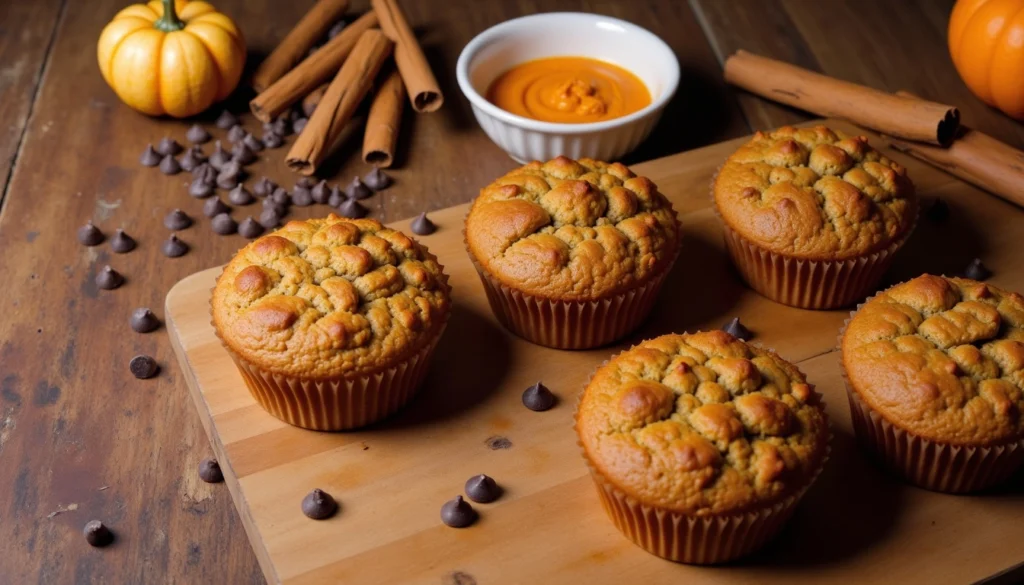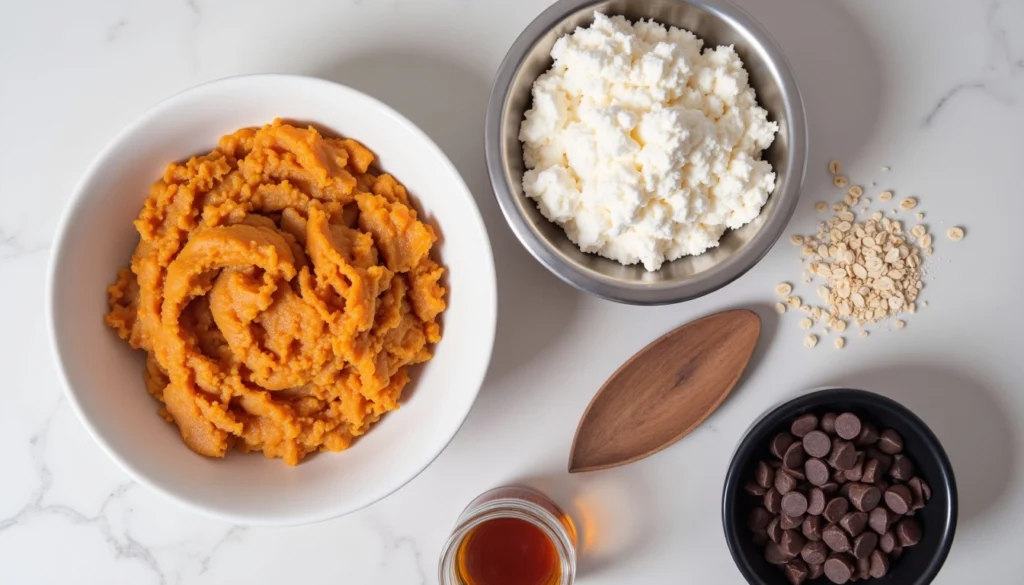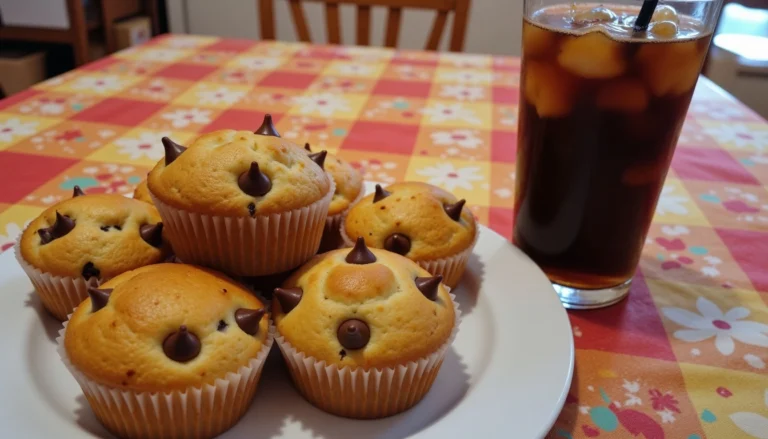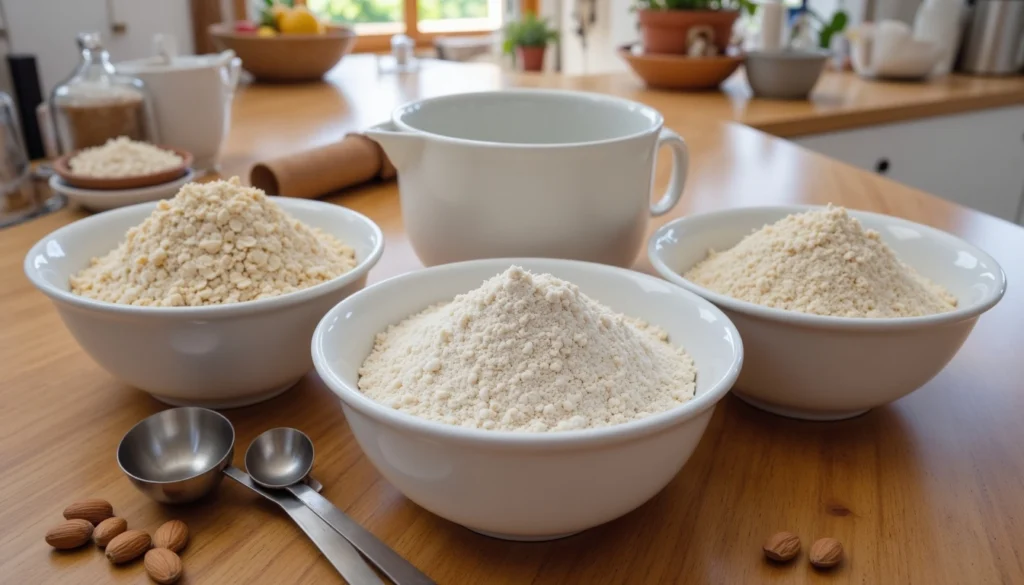The Best Protein Pumpkin Muffins Recipe for a Healthy, High-Protein Treat

Are you searching for a delicious, high-protein snack that perfectly embodies the cozy warmth of pumpkin spice season? Look no further! These Protein Pumpkin Muffins are not only irresistibly tasty but also packed with healthy protein, making them the perfect post-workout snack or morning grab-and-go option. Combining the rich flavors of pumpkin puree, chocolate chips, and a boost from protein powder, this muffin recipe is a must-try.
Read on to discover how to make these pumpkin protein muffins with simple ingredients and tips for customizing them to your dietary preferences.
Pumpkin lovers will enjoy exploring even more delicious and creative pumpkin breakfast recipes that fit any morning routine.
Why the Are the Ultimate Healthy Snack
When fall comes around, pumpkin-flavored treats are everywhere—but most of them are loaded with sugar and lack high protein content. Enter the pumpkin protein muffin: a deliciously moist and flavorful alternative that delivers 8 grams of protein per muffin while satisfying your cravings for something sweet.
These muffins are versatile too. Whether you enjoy them as a pre-workout snack, a breakfast option, or a dessert, they strike the perfect balance between indulgence and nutrition.
What Makes a Muffin High in Protein?
The key to a high-protein muffin recipe lies in incorporating protein-rich ingredients like protein powder, Greek yogurt, and almond flour. By replacing traditional flour with protein-enhanced alternatives, you can easily increase the grams of protein per muffin.
- Greek yogurt adds creaminess and a boost of fiber and protein.
- Protein powder, whether whey protein powder or plant-based protein, provides concentrated nutrition.
- Almond flour not only complements the nutty undertones of pumpkin spice but also improves texture.
Essential Ingredients for Protein Pumpkin Muffins
To make these pumpkin protein muffins, you’ll need:
- Pumpkin puree: Provides moisture and a natural pumpkin flavor.
- Oat flour or almond flour: For a gluten-free option that doesn’t compromise taste.
- Vanilla protein powder: Adds protein and a subtle sweetness.
- Greek yogurt: Enhances the moistness and protein content.
- Maple syrup: A natural sweetener that pairs well with pumpkin pie spice.
- Chocolate chips: Optional but highly recommended for a touch of indulgence.
Pro Tip: Avoid using pumpkin pie filling, which is pre-sweetened and may throw off the flavor balance.

Choosing the Right Protein Powder for Protein Pumpkin Muffins
Selecting the right protein powder can make or break your muffins. Look for:
- Unflavored protein powder if you want the pumpkin spice to stand out.
- Chocolate protein powder for a richer, dessert-like taste.
- A whey protein powder or plant-based protein option, depending on dietary needs.
Each scoop of vanilla protein powder or whey protein can add protein without altering the texture.
Step-by-Step Recipe Guide
Here’s a foolproof guide to make pumpkin protein muffins:
Print
The Best Pumpkin Protein Muffins Recipe for a Healthy, High-Protein Treat
Soft, moist, and packed with flavor, these pumpkin protein muffins combine the cozy taste of pumpkin spice with a healthy boost of protein. Perfect as a snack, breakfast, or post-workout fuel!
- Total Time: 35 minutes
- Yield: 12 muffins 1x
Ingredients
- 1 cup pumpkin puree
- 1/2 cup Greek yogurt
- 1/3 cup maple syrup
- 2 scoops vanilla protein powder
- 1 cup oat flour
- 1/2 teaspoon baking soda
- 1 teaspoon baking powder
- 1 teaspoon pumpkin pie spice
- 1/4 cup chocolate chips
Instructions
- Preheat oven to 350°F and line a muffin tin with liners.
- In a bowl, whisk together pumpkin puree, Greek yogurt, maple syrup, and vanilla extract until smooth.
- In another bowl, combine oat flour, baking soda, baking powder, and pumpkin pie spice.
- Gradually mix the dry ingredients into the wet mixture until just combined.
- Fold in the chocolate chips.
- Divide batter evenly into the prepared muffin tin.
- Bake for 20–25 minutes, or until a toothpick comes out clean.
- Let muffins cool for 5 minutes in the tin before transferring to a wire rack.
Notes
- For a gluten-free option, ensure you use certified gluten-free oat flour.
- You can substitute chocolate chips with nuts or dried fruits for variety.
- Store muffins in an airtight container at room temperature for up to 3 days, or freeze for up to 3 months.
- Prep Time: 10 minutes
- Cook Time: 25 minutes
- Category: Breakfast, Snack
- Method: Baking
- Cuisine: American
Nutrition
- Serving Size: 1 muffin
- Calories: 120
- Sugar: 5g
- Sodium: 180mg
- Fat: 4g
- Saturated Fat: 1g
- Unsaturated Fat: 3g
- Trans Fat: 0g
- Carbohydrates: 15g
- Fiber: 2g
- Protein: 8g
- Cholesterol: 10mg
Keywords: Pumpkin protein muffins, high-protein breakfast, healthy pumpkin recipe, protein-packed muffins
If you love pumpkin-based treats, don’t miss this simple pumpkin pancake mix recipe to expand your breakfast options
Can You Make These Pumpkin Muffins Gluten-Free?
Absolutely! Making pumpkin protein muffins gluten-free is not only easy but also enhances their nutritional value. By swapping traditional wheat flour with gluten-free alternatives like oat flour or almond flour, you can enjoy these muffins without worrying about gluten intolerance or sensitivity. Here’s a breakdown of how to achieve perfectly fluffy and moist gluten-free pumpkin muffins.

Choosing the Best Gluten-Free Flour Alternatives
When it comes to replacing flour, it’s important to choose options that provide structure while maintaining the moist and soft texture of the muffins. Some great choices include:
- Oat Flour
- Oat flour is a popular gluten-free substitute because it’s light, nutritious, and easy to make at home by grinding rolled oats.
- Its mild flavor complements the pumpkin spice and blends well with the other ingredients.
- Be sure to use certified gluten-free oats if you’re sensitive to gluten.
- Almond Flour
- Made from finely ground almonds, almond flour adds a slightly nutty flavor and works perfectly for healthy pumpkin protein muffins.
- It’s packed with protein, making it a fantastic choice to boost the grams of protein per muffin.
- Note that almond flour is heavier than oat flour, so it’s best to combine it with a lighter gluten-free flour for balanced texture.
- Coconut Flour
- While coconut flour is another gluten-free option, it’s highly absorbent and can make the muffins dry if not used properly. Use it sparingly, often in combination with other flours, to avoid overly dense muffins.
Adjusting the Recipe for Gluten-Free Success
Switching to gluten-free flours may require slight adjustments to your muffin recipe. Here are some tips to ensure success:
Use Baking Powder and Baking Soda
To help gluten-free muffins rise, make sure to include both baking powder and baking soda. These leavening agents create the lift and airy texture you want.
Increase the Liquid Ingredients
Gluten-free flours, especially coconut flour, absorb more liquid than regular flour. Adding extra Greek yogurt, pumpkin puree, or even a splash of milk can prevent the muffins from becoming dry.
Combine Multiple Flours
A blend of oat flour and almond flour often provides the best results, balancing structure and moisture.
Don’t Overmix the Batter
Gluten-free batters are more delicate. Overmixing can result in muffins that don’t rise well or have a gummy texture.
Sweeteners: Maple Syrup vs. Sugar
When it comes to sweetening your pumpkin protein muffins, choosing the right sweetener is key to balancing flavor, nutrition, and texture. Traditional sugar and maple syrup are two common choices, each with its pros and cons. Here’s a detailed comparison to help you decide which one works best for your muffin recipe.
Maple Syrup: A Natural Sweetener with Rich Flavor
Maple syrup is an excellent alternative to refined sugar, especially in healthy pumpkin muffin recipes. It brings a unique, caramel-like sweetness that complements the warm notes of pumpkin pie spice and the richness of pumpkin puree.
Benefits of Using Maple Syrup:
- Natural Sweetness: Unlike refined sugar, maple syrup is minimally processed, retaining trace minerals like manganese and zinc.
- Moisture-Retaining Properties: Its liquid consistency helps keep pumpkin muffins moist and tender.
- Flavor Pairing: The complex flavor profile of maple syrup enhances the earthy sweetness of pumpkin flavor.
How to Use Maple Syrup in Muffins:
- Replace sugar with an equal amount of maple syrup for a naturally sweetened batter.
- Reduce other liquids in the recipe slightly (e.g., Greek yogurt or milk) to maintain the right consistency.
Considerations:
- Maple syrup can make muffins darker in color due to caramelization.
- It’s slightly less sweet than sugar, so you may need to use a bit more if you prefer a sweeter muffin.
Sugar: The Classic Sweetener
Granulated sugar is the most traditional sweetener used in baking. While it lacks the nutritional benefits of maple syrup, it delivers reliable sweetness and helps create a more structured muffin.
Benefits of Using Sugar:
- Neutral Flavor: Sugar provides sweetness without altering the flavor of other ingredients, letting the pumpkin spice and chocolate chips shine.
- Structure and Texture: Sugar helps create a fine crumb and aids in browning during baking.
- Consistency: It’s easy to measure and works seamlessly in most recipes.
How to Use Sugar in Muffins:
- Stick to the same amount as specified in the recipe, typically 1/3 to 1/2 cup for a dozen muffins.
- Combine sugar with wet ingredients (e.g., pumpkin puree) to ensure it dissolves evenly.
Considerations:
- Sugar doesn’t add moisture, so you’ll need to rely on ingredients like Greek yogurt or pumpkin puree for that.
- Refined sugar is higher on the glycemic index, which may be a concern for those monitoring blood sugar levels.
Comparing Nutritional Profiles
| Sweetener | Calories (per 1 tbsp) | Glycemic Index | Notable Nutrients |
|---|---|---|---|
| Maple Syrup | 52 | 54 | Manganese, zinc, antioxidants |
| Granulated Sugar | 49 | 65 | None |
Key Takeaway: While maple syrup has slightly more calories, it has a lower glycemic index and provides trace nutrients that sugar lacks.
Tips for Perfectly Moist Pumpkin Muffins
Dry muffins are a common issue, but with these tips, your pumpkin protein muffins will always turn out moist:
- Use Greek yogurt to lock in moisture.
- Don’t overmix the pumpkin muffin batter; this can result in tough muffins.
- Bake at the right temperature and let the muffins cool properly to retain softness.
Adding Chocolate Chips Without Overpowering the Pumpkin Flavor
While chocolate chips add a delightful touch, they shouldn’t overwhelm the pumpkin spice notes. Here’s how to strike the right balance:
- Use mini chocolate chips for an even distribution.
- Stick to dark or semi-sweet chocolate, which pairs well with healthy pumpkin flavors.
- Avoid overloading the batter; 1/4 cup is plenty for most recipes.
Storing : How Long Do They Last?
Proper storage is essential to keep your pumpkin protein muffins fresh, flavorful, and ready to enjoy whenever you need a snack. Whether you’ve made a large batch or want to prepare ahead for the week, knowing the best ways to store them can extend their shelf life without compromising texture or taste.
Here’s a complete guide to storing your muffins for short- and long-term enjoyment.
Room Temperature Storage
If you plan to enjoy your pumpkin protein muffins within a few days, storing them at room temperature is the easiest option.
How to Store at Room Temperature:
- Allow the muffins to cool completely before storing them. Placing warm muffins in a container can trap moisture, leading to sogginess or mold.
- Place the muffins in an airtight container or wrap them tightly in plastic wrap or aluminum foil.
- Keep the container in a cool, dry place, away from direct sunlight or heat.
Shelf Life:
When stored correctly, the muffins will stay fresh at room temperature for up to 3 days.
Pro Tip: Add a small sheet of paper towel inside the container to absorb excess moisture and keep the muffins’ texture perfect.
Refrigeration
For longer freshness, refrigeration is a great option. Refrigerating the muffins will help preserve their moisture and prevent spoilage, especially if they include perishable ingredients like Greek yogurt or pumpkin puree.
How to Refrigerate:
- After the muffins cool completely, place them in an airtight container or sealable food storage bag.
- Separate layers with parchment paper to prevent them from sticking together.
Shelf Life:
Refrigerated muffins will stay fresh for up to 1 week.
Pro Tip: Warm refrigerated muffins in the microwave for 10–15 seconds before eating to bring back their soft, fresh-baked texture.
Freezing for Long-Term Storage
Freezing is the best option if you’ve made a big batch or want to meal prep for the month. Properly frozen pumpkin protein muffins retain their taste, texture, and nutritional value.
How to Freeze:
- Ensure the muffins have cooled completely to prevent ice crystals from forming inside the muffins.
- Place the muffins on a baking sheet in a single layer and freeze for 1–2 hours. This prevents them from sticking together.
- Transfer the frozen muffins to a freezer-safe airtight container or zip-top bag.
- Label the container with the date to keep track of their storage time.
Shelf Life:
Frozen muffins can last for up to 3 months.
How to Thaw:
- Remove muffins from the freezer and let them thaw at room temperature for about 30–60 minutes.
- For quicker results, microwave a muffin for 20–30 seconds on medium heat.
Pro Tip: Freeze muffins individually wrapped in plastic wrap or foil to make it easy to grab one on the go.
Signs That Muffins Have Gone Bad
No one wants to bite into spoiled muffins! Check for these signs before consuming stored muffins:
Texture Changes: Muffins that feel overly sticky, slimy, or unusually dry may have gone bad.
Mold: Visible mold or discoloration is an immediate indicator that the muffins are no longer safe to eat.
Off Smell: Any sour or rancid smell suggests spoilage.
FAQ
What is the secret to moist muffins?
The key to moist muffins lies in balancing your wet and dry ingredients. Here are a few secrets:
Greek yogurt or sour cream: These add moisture without making the batter too wet.
Pumpkin puree: Naturally keeps the muffins soft and prevents dryness.
Don’t overmix: Overmixing the batter can make muffins dense and dry. Mix just until the ingredients are combined.
Proper baking time: Overbaking dries out muffins, so remove them as soon as a toothpick comes out clean
What are pumpkin muffins made of?
Pumpkin muffins are typically made with:
Pumpkin puree: For flavor and moisture.
Flour: All-purpose, oat flour, or almond flour, depending on the recipe.
Sweeteners: Such as sugar or maple syrup.
Spices: Pumpkin pie spice, cinnamon, or nutmeg for that cozy fall flavor.
Eggs: To bind the ingredients and provide structure.
Leavening agents: Baking powder or baking soda to help the muffins rise.
Optional ingredients include chocolate chips, nuts, or dried fruits for added flavor and texture.
What is the difference between canned pumpkin and pumpkin puree?
Canned pumpkin: Refers to plain, cooked, and pureed pumpkin, which is unseasoned and commonly used in baking.
Pumpkin pie filling: A sweetened and spiced mixture that includes sugar and spices, designed for pies.
Always use canned pumpkin puree for recipes like muffins to control the sweetness and spice levels.
Why are my pumpkin muffins wet?
Overly wet pumpkin muffins are often caused by:
Too much wet ingredients: Adding extra pumpkin puree, Greek yogurt, or milk can make the batter too moist. Measure carefully.
Underbaking: Muffins not baked long enough will remain wet in the center. Bake until a toothpick inserted in the middle comes out clean.
Improper ingredient ratio: Balancing the wet-to-dry ratio is critical. If you’re using a gluten-free flour like oat or almond flour, you may need less liquid.
Conclusion
Pumpkin protein muffins are the perfect way to enjoy the cozy flavors of fall while staying on track with your health goals. Packed with protein, fiber, and all the warm notes of pumpkin spice, these muffins are as nutritious as they are delicious. Whether you enjoy them as a quick breakfast, a pre-workout snack, or a satisfying dessert, they’re versatile enough to fit any occasion.
By using wholesome ingredients like pumpkin puree, Greek yogurt, and your favorite protein powder, you can easily customize this recipe to suit your dietary preferences, including gluten-free and dairy-free options. With just a few simple steps, you’ll have a batch of moist, flavorful muffins that are sure to become a seasonal favorite.
So, grab your mixing bowl, preheat the oven, and treat yourself to a healthier take on pumpkin-inspired baking. These muffins are more than just a snack—they’re a celebration of fall in every bite! Happy baking!







9 Comments